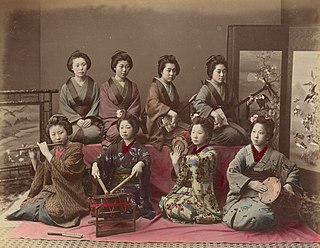
The tambourine is a musical instrument in the percussion family consisting of a frame, often of wood or plastic, with pairs of small metal jingles, called "zills". Classically the term tambourine denotes an instrument with a drumhead, though some variants may not have a head. Tambourines are often used with regular percussion sets. They can be mounted, for example on a stand as part of a drum kit, or they can be held in the hand and played by tapping, hitting, or shaking the instrument.

String instruments, stringed instruments, or chordophones are musical instruments that produce sound from vibrating strings when a performer plays or sounds the strings in some manner.
Hornbostel–Sachs or Sachs–Hornbostel is a system of musical instrument classification devised by Erich Moritz von Hornbostel and Curt Sachs, and first published in the Zeitschrift für Ethnologie in 1914. An English translation was published in the Galpin Society Journal in 1961. It is the most widely used system for classifying musical instruments by ethnomusicologists and organologists. The system was updated in 2011 as part of the work of the Musical Instrument Museums Online (MIMO) Project.
A membranophone is any musical instrument which produces sound primarily by way of a vibrating stretched membrane. It is one of the four main divisions of instruments in the original Hornbostel-Sachs scheme of musical instrument classification.

An idiophone is any musical instrument that creates sound primarily by the vibration of the instrument itself, without the use of air flow, strings (chordophones), membranes (membranophones) or electricity (electrophones). It is the first of the four main divisions in the original Hornbostel–Sachs system of musical instrument classification. The early classification of Victor-Charles Mahillon called this group of instruments autophones. The most common are struck idiophones, or concussion idiophones, which are made to vibrate by being struck, either directly with a stick or hand or indirectly, with scraping or shaking motions. Various types of bells fall into both categories. A common plucked idiophone is the Jew's harp.
In music, a bow is a tensioned stick which has hair coated in rosin affixed to it. It is moved across some part of a musical instrument to cause vibration, which the instrument emits as sound. The vast majority of bows are used with string instruments, such as the violin, viola, cello, and bass, although some bows are used with musical saws and other bowed idiophones.

The erhu is a Chinese two-stringed bowed musical instrument, more specifically a spike fiddle, which may also be called a Southern Fiddle, and is sometimes known in the Western world as the Chinese violin or a Chinese two-stringed fiddle.

The cuíca is a Brazilian friction drum with a large pitch range, produced by changing tension on the head of the drum. Cuíca is Portuguese for the gray four-eyed opossum which is known for its high-pitched cry. It is frequently used in carnivals, as well as often in samba music. The tone it produces has a high-pitched squeaky timbre. It has been called a 'laughing gourd' due to this sound. Many also liken its sound to that of a monkey.

The davul, dhol, tapan, atabal or tabl is a large double-headed drum that is played with mallets. It has many names depending on the country and region. These drums are commonly used in the music of the Middle East and the Balkans. These drums have both a deep bass sound and a thin treble sound due to their construction and playing style, where different heads and sticks are used to produce different sounds on the same drum.

The lion's roar is a membranophone instrument that has a drum head and a cord or horsehair passing through it. It gets its name from the sound it produces, which closely resembles a lion's roar. The home-made lion's roar is a drum that sits on the floor. The cord then makes friction with the drum head as it is moved back and forth.
The music of Central Asia is as vast and unique as the many cultures and peoples who inhabit the region. Principal instrument types are two- or three-stringed lutes, the necks either fretted or fretless; fiddles made of horsehair; flutes, mostly sige at both ends and either end-blown or side-blown; and jew harps, mostly metal. Percussion instruments include frame drums, tambourines, and kettledrums. Instrumental polyphony is achieved primarily by lutes and fiddles.

A tabor, tabret (Welsh: Tabwrdd), Tambour De Provence, or Tambourin (Provencal) is a portable snare drum typically played either with one hand or with two drumsticks. The word "tabor" is simply an English variant of a Latin-derived word meaning "drum"—cf. French: tambour, Italian: tamburo It has been used in the military as a marching instrument, and has been used as accompaniment in parades and processions.

The yazheng is a Chinese string instrument. It is a traditional zither similar to the guzheng but bowed by scraping with a rosined stick or a horsehair bow,. The musical instrument was popular in the Tang dynasty, but is today little used except in the folk music of some parts of northern China, where it is called yaqin.

The bladder fiddle was a folk instrument used throughout Europe and in the Americas. The instrument was originally a simple large stringed fiddle made with a long stick, one or more thick gut strings, and a pig's-bladder resonator. It was bowed with either a notched stick or a horsehair bow.
Mazanka is a Ukrainian traditional house, which is built of clay and has traditional patterns on the walls and a thatched or wooden roof. It is also a Slavic instrument:

Traditional Japanese musical instruments, known as wagakki (和楽器) in Japanese, are musical instruments used in the traditional folk music of Japan. They comprise a range of string, wind, and percussion instruments.

The buhay is a musical instrument that is used in Ukraine and is classified as a friction drum. Buhay is the Ukrainian word for great bittern, and its use as name of the instrument refers to the sound produced. The mating call or contact call of the male Buhay is a deep, sighing fog-horn or bull-like boom with a quick rise and an only slightly longer fall, easily audible from a distance of 3 mi on a calm night.

Ukrainian folk music includes a number of varieties of traditional, folkloric, folk-inspired popular music, and folk-inspired European classical music traditions.

There are several overlapping schemes for the classification of percussion instruments.















